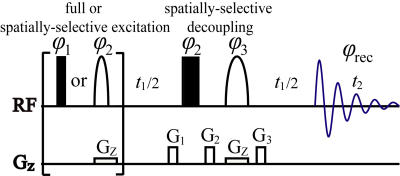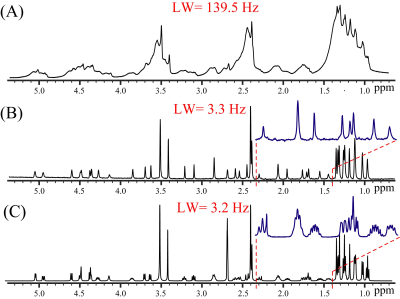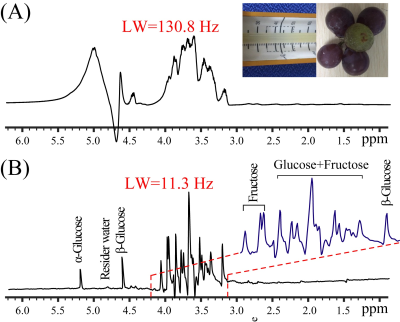2903
High-resolution measurements on heterogeneous samples by spatially-selective pure shift NMR spectroscopy1Department of Electronic Science, Xiamen University, Xiamen, China
Synopsis
Measurements on heterogeneous samples, such as semisolid food and biological tissues, constitute a significant research topic in various fields. However, measurements on heterogeneous samples by conventional 1D 1H NMR generally suffer from two challenges, namely magnetic field inhomogeneity caused by anisotropic interactions and spectral congestion induced by crowded NMR resonances. In this report, we introduce a spatially-selective pure shift NMR approach for high-resolution measurements on heterogeneous samples based on the suppression on effects of magnetic field inhomogeneity and J couplings, thus useful for investigating heterogeneous sample systems with extensive chemical and biological applications.
INTRODUCTION
NMR spectroscopy presents a powerful tool for furnishing molecular-level information including molecular structures, chemical compositions, and dynamic processes.1 Measurements on heterogeneous samples, such as semisolid food and biological tissues, constitute a significant research topic in various fields throughout food science, biology, and medicine.2 However, measurements on heterogeneous samples by conventional 1D 1H NMR generally suffer from two challenges, namely magnetic field inhomogeneity caused by anisotropic interactions and spectral congestion induced by crowded NMR resonances.3 First, field inhomogeneity caused by intrinsic anisotropic interactions in heterogeneous samples would generate line broadening effects, directly degrading spectral resolution. Second, heterogeneous samples characteristically contains numerous chemical compositions along with crowded NMR resonances, leading to spectral congestion in acquired spectra. In this report, we introduce a spatially-selective pure shift NMR approach for high-resolution measurements on heterogeneous samples based on the suppression on effects of magnetic field inhomogeneity and J couplings.METHODS
The pulse sequence diagram for spatially-selective pure shift experiments are shown in Fig. 1. is composed of a π/2 selective/non-selective excitation pulse, two indirect evolution period t1/2, a spatially-selective decoupling module4, consisting of a non-selective inversion pulse and a selective inversion pulse combined with a simultaneous weak gradient. This spatially-selective decoupling module introduces a spatial effect dependent on different slices of sample tube. In a certain spatial slice, the selected spin by the selective inversion pulse experiences the overall 360o rotation, indicating no net significant effects, while other spins in this slice which are not selected merely experiences the single 180o rotation, resulting in a net inversion. Experiencing two symmetric indirect evolution period t1/2, J coupling evolution is refocused while chemical shift evolution remains undisturbed. A synthetic dataset is obtained by concatenating a series of t2-dimension data chunks of 1/SW1 duration with different t1 increments. After 1D Fourier transformation (FT) over the synthetic dataset, pure shift spectra can be obtained with the elimination of J coupling splittings. Benefitting from the reduced sample volume per signal, spatially-selective experiments are tolerant to field inhomogeneity along the z direction. Thus, the spatially-selective pure shift experiment is capable of overcoming both challenges of field inhomogeneity and spectral congestion, suitable for high-resolution measurements on heterogeneous samples.All experiments were performed at 295 K using a Varian NMR System (Varian 500 MHz spectrometer, Agilent Technologies, Santa Clara, CA, USA), equipped with a 5 mm XYZ indirect detection probe. Two heterogeneous samples, a complex sample of azithromycin under externally inhomogeneous magnetic fields, and a biological sample of intact grape tissues with macroscopic magnetic susceptibility variations and crowded NMR resonances, are tested to verify the effectiveness and applicability of the spatially-selective pure shift NMR spectroscopy.
RESULTS
Measurements on azithromycin, a clinical macrolide antibiotic, performed under an inhomogeneous field are presented in Fig. 2. Under the inhomogeneous field, severe inhomogeneous line broadenings ruin all useful information in the standard 1D spectrum (Fig. 2A). In contrast, inhomogeneous line broadening and J coupling splitting are eliminated in the resulting spatially-selective pure shift spectrum (Fig. 2B), thus providing high-resolution information for analyses, even for the congested spectral region between 1.4 and 2.4 ppm. Standard 1D NMR spectrum acquired in a well-shimmed field is also given for comparison (Fig. 2C).Experimental results on intact grape tissues are shown in Fig. 3. Because intact grape tissues are characterized with the intrinsic magnetic susceptibility variations and metabolites with crowded NMR resonances, spectral congestion and line broadening lead to a broad peak envelope of 130.8 Hz in the standard water-presaturated 1D NMR spectrum (Fig. 3A), hindering almost all useful spectral information. Fortunately, high-resolution 1D measurement can be achieved by the spatially-selective pure shift experiment (Fig. 3B). The spectral resolution is improved from 130.8 Hz to 11.3 Hz, and complex multiplets are simplified into singlets, facilitating metabolite assignments even for the overlapped region between 3.0 and 4.2 ppm.
DISCUSSION
It can be seen that the spatially-selective pure shift spectroscopy presents an effect tool for high-resolution measurements on heterogeneous systems that contains field inhomogeneity and crowded NMR resonances. Compared to conventional 1D NMR, field inhomogeneity effect can be eliminated and all multiplet resonances can be simplified into singlets in spatially-selective pure shift experiments, benefitting to high-resolution measurements on biological tissues with intrinsic field inhomogeneity and complex metabolites. Due to the implementation of reduced sample volumes, spatially-selective pure shift experiments suffers the lower signal intensity than conventional 1D NMR, and improvement of this method for wide applications may be achieved by combining with other pulse sequence techniques and data processing approaches.CONCLUSION
Here, we demonstrate a spatially-selective pure shift NMR approach for high-resolution measurements on heterogeneous samples by suppressing effects of magnetic field inhomogeneity and J couplings. This approach may provide a different perspective to existing pure shift NMR applications and presents interesting prospects for investigating heterogeneous samples.Acknowledgements
This work was partially supported by the NNSF of China under Grants 11675135 and 21327001.References
1. Evangelidis T, Nerli S, Novacek J, Brereton AE, Karplus PA, Dotas RR, Venditti V, Sgourakis NG, Tripsianes K, Automated NMR resonance assignments and structure determination using a minimal set of 4D spectra. Nat. Commun. 2018, 9(1):384.
2. Mannina L, Sobolev AP, Viel S, Liquid state 1H high field NMR in food analysis. Proc. Nucl. Magn. Reson.,Spectrosc. 2012, 66:1-39.
3. Huang YQ, Cao SH, Yang Y, Cai SH, Zhan HL, Tan CH, Lin LJ, Zhang ZY, Chen Z., Ultrahigh-resolution NMR spectroscopy for rapid chemical and biological applications in inhomogeneous magnetic fields. Anal. Chem. 2017, 89(13):7115-7122.
4. Zangger K, Sterk H, Homonuclear broadband-decoupled NMR spectra. J. Magn. Reson. 1997, 124(2):486-489.
Figures


